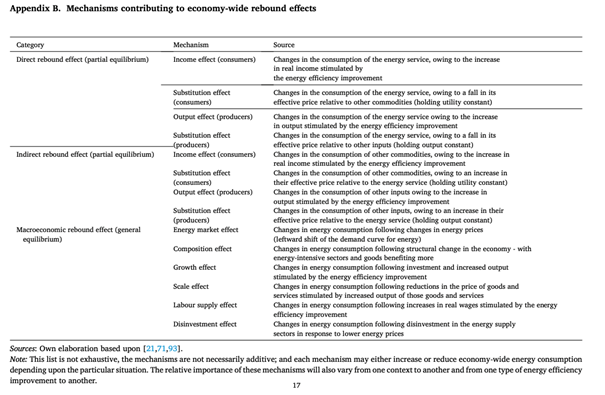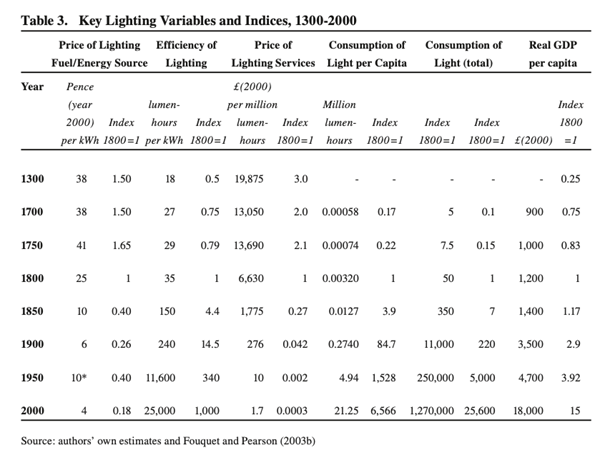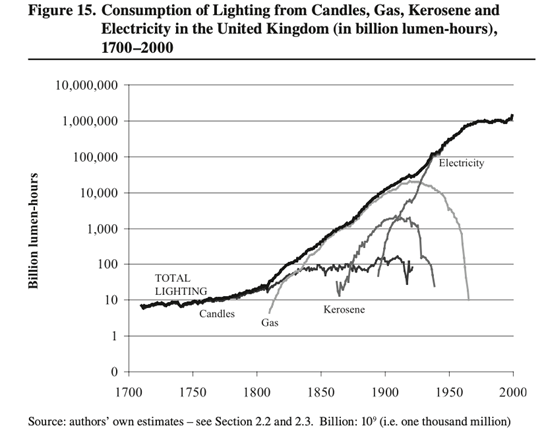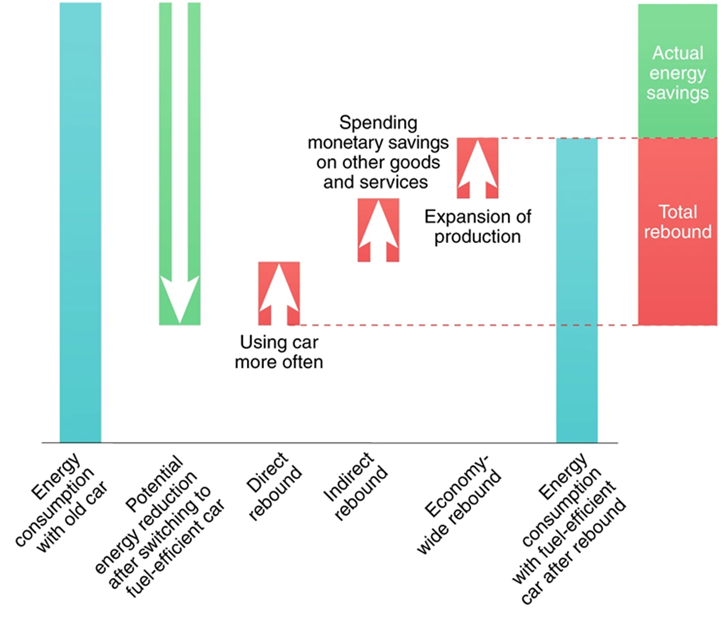This text has been translated by a machine and has not been reviewed by a human yet. Apologies for any errors or approximations – do not hesitate to send us a message if you spot some!
To reduce energy consumption, public policies promote energy efficiency 1 which involves harnessing technology to produce goods and services that consume less energy per unit. Examples include home insulation, the development of more efficient heating systems, lower vehicle consumption per km travelled, more efficient light bulbs and so on. The “rebound effect” is the reduction, or even cancellation, of the energy savings expected as a result of progress in energy efficiency, due to a combination of economic and behavioral factors that we will explain in this fact sheet.
The rebound effect can be summarized by the following formula: rebound effect (%) = 1 – (savings achieved/savings expected) For example, a rebound effect of 40% means that 40% of the energy savings expected from the deployment of a new technology were not achieved, due to an increase in energy use linked to various economic or behavioral factors (which we present in section 1.B).
This effect, which has been empirically demonstrated in a number of different sectors, calls for public policies that go beyond simply improving efficiency, which of course remains desirable. 2
Definitions and mechanisms of the rebound effect
From Jevons’ paradox to the rebound effect
It was Williams Stanley Jevons who first highlighted the rebound effect. 3 . Drawing on the debates surrounding the fear of a coal shortage in England in the 1860s 4 in his book The Coal Question (1865), he noted a paradox: despite the improved energy efficiency of the steam engine, total coal consumption had increased. This became known as “Jevons’ paradox”: an improvement in energy efficiency could lead to an increase in energy consumption.
For Jevons, this paradox is only apparent: it is, in fact, the greater energy efficiency of steam engines that encourages and enables entrepreneurs to produce more, and thus ultimately leads them to use more coal than before.
It wasn’t until the late 1970s that Jevons’ reasoning was taken up again and the rebound effect was truly theorized. The work of economists Leonard Brookes and Daniel Khazzoom 5 marked the beginning of a vast literature on this key topic of ecological transition.
The rebound effect occurs as soon as energy consumption gains are less than proportional to individual efficiency gains. This effect can vary in magnitude. If a machine saves 10% fuel, but fuel consumption only drops by 8%, we’re already talking about a rebound effect.
The extreme case, as described by Jevons in 1865, is when individual efficiency gains (per appliance) result not in energy savings (even lower than expected), but in higher energy consumption. The income effect and general equilibrium mechanisms described below then come into full play, and energy efficiency, far from bringing about an ecological improvement, actually worsens the situation. This is known as the “backfire effect”.
The different types of rebound effect
Researchers distinguish three types of rebound effect. 6
The first two are microeconomic: it is possible (especially for the direct effect) to observe them empirically at the level of economic players. There is also another effect that concerns the economy as a whole.
1. The direct rebound effect (or price effect): an increase in the energy efficiency of a product lowers its price and leads to greater consumption of that good (or the service it provides). For example, the fall in the price of lighting as a result of efficiency gains in this area can encourage people to be careless about turning off unnecessary lights. Other examples include cars (lower fuel consumption per km thanks to improved engines may encourage people to travel more), or home insulation (lower heating consumption thanks to better insulation may encourage people to raise the average temperature).
2. The indirect rebound effect (or income effect): the financial savings made possible by lower energy consumption (of the car, heating, electricity) are used to consume other goods requiring energy (e.g. to take a plane trip).
3. The macroeconomic rebound effect, which can result from two mechanisms:
- the reduction in total energy demand made possible by energy efficiency leads to lower energy prices, which can stimulate energy-intensive sectors of the economy
- improved energy efficiency generates economic growth, which in turn leads to higher energy consumption across the economy as a whole.
4. The total rebound effect: this is the sum of the direct, indirect and macroeconomic effects.
Note that there are differences in terminology among economists studying the phenomenon. For example, in the diagram below, the macroeconomic rebound effect is referred to as the ” Economy-wide rebound effect “, whereas in the table below, this expression refers to the total rebound effect.
It can be confusing!
Estimates of the total rebound effect
While the average direct rebound effect is now relatively well studied 7 the indirect and macroeconomic effects are more difficult to measure.
In an article published in 2021, several economists reviewed various academic studies aimed at estimating the economy-wide rebound effect, using a wide variety of methodologies. The conclusion of this literature review is very clear: the total rebound effect can erode by at least half the energy savings expected from improved energy efficiency.
Summary of the different mechanisms contributing to the rebound effect

Source Paul E. Brockway et al, Energy efficiency and economy-wide rebound effects: A review of the evidence and its implications, Renewable and Sustainable Energy Reviews, 2021.
An example of the rebound effect: the UK lighting sector
In their article ” Seven Centuries of Energy Services: The Price and Use of Light in the United Kingdom (1300-2000) “, published in 2007 in The Energy Journal, Roger Fouquet and Peter J.G. Pearson analyze the evolution of lighting production technologies and consumption over several centuries in the UK.
Key variables and indices for the lighting sector, 1300-2000

Source R. Fouquet and Peter J.G. Pearson (2007), ” Seven Centuries of Energy Services: The Price and Use of Light in the United Kingdom (1300-2000) “, Energy Journal, vol. 27, n°1, pp. 139-177.
The table above shows the order of the columns:
- A drop in the average price of the energy sources that generate light from 25 pence per kWh in 1800 to 4 in 2000, a division by more than 6 (in constant currency).
- A major improvement in lighting efficiency, from 35 lumens per kWh in 1800 to 25,000 lumens per kWh in 2000. 8 a more than 700-fold increase in efficiency.
- A concomitant fall in the price of lighting services: in the year 2000, British consumers paid 160 times less for access to a million lumens than in 1900, and almost 4,000 times less than in 1800.
- At the same time, light consumption has increased massively, both per capita (a 6,566-fold increase since 1800) and in total, reaching over 1270 trillion lumens (a 25,000-fold increase).
This can also be seen in the following graph, which also shows the succession of different energy sources used for lighting (candle, gas lamp, kerosene lamp and electric bulb).
Light consumption by source in the United Kingdom, 1700-2000

Source R. Fouquet and Peter J.G. Pearson (2007), ” Seven Centuries of Energy Services: The Price and Use of Light in the United Kingdom (1300-2000) “, Energy Journal, vol. 27, n°1, pp. 139-177.
As costs have fallen, the demand for and use of artificial light has risen sharply, not only by individuals, but also through the development of outdoor lighting for streets and buildings.
On average, a UK resident consumed 75 times more artificial light in 2000 than in 1900, and 6,600 times more than in 1800.
It’s a perfect illustration of Jevons’ paradox: sharp increases in energy efficiency have led to a sharp reduction in lighting costs, leading to an increase in lighting demand and total energy consumption.
How to explain the rebound effect and how to reduce it
Explaining the rebound effect: theoretical and empirical perspectives
From a theoretical point of view, the rebound effect has an intuitive explanation: in a production process, individual energy efficiency gains translate into lower energy-related unit costs (less energy is needed to produce a unit of good, so it’s cheaper), which creates an incentive to produce more goods or consume more energy elsewhere.
Here, price acts as an unfavorable signal.
However, the rebound effect is above all an empirical subject, and from this point of view, the question is more delicate.
If we observe rebound effects in a given sector, we can’t claim that technical progress will be the only solution for reducing energy consumption. This is illustrated by the above example of the lighting sector in the UK, which has been subject to significant rebound effects. In 200 years, the price of energy for lighting purposes has been divided by more than six. The technical efficiency of lighting (in lumens) has improved considerably, but this has not led to a reduction in lighting consumption – quite the contrary. In fact, the efficiency gains achieved have been more than offset.
In the same way, between the 1950s and today, vehicle combustion engines have made extraordinary progress, but the consumption associated with transporting people and goods has, on the contrary, increased. Why did this happen? Because instead of reducing the amount of fuel consumed by each vehicle, efficiency gains have been used to make vehicles heavier, more comfortable, more powerful and, above all, to cover greater distances.
For other sectors, such as digital 9 the rebound effect is linked to the relentless development of the services and uses offered thanks to the ever-increasing power of the chips present in computers and many everyday objects. Energy efficiency gains are “absorbed” by the multiplication of uses. 10
In key sectors of the ecological transition, such as construction, questions remain unanswered. Better materials and insulation are undeniably necessary. But how can we guarantee that better boilers or windows won’t lead users to turn up their thermostats or heat rooms previously left cold, thus generating a rebound effect? 11 In fact, this is sometimes desirable in the case of “thermal flats”, whose inhabitants may suffer from insufficient temperature and/or excessive humidity, because they simply can’t afford the price of sufficient heating. In this case, energy efficiency allows the occupant to improve his or her comfort at a constant cost, although it’s not certain that he or she will consume less energy (in this case, it all depends on the depth of the renovation).
How to get around the rebound effect?
This is why, in many fields, researchers are suggesting that technical gains in energy efficiency should be accompanied by regulatory mechanisms or behavioral incentives. 12 to ensure that they translate into real reductions in consumption, rather than rebounds. 13
The rebound effect, a simple economic mechanism that has been identified for over a century, shows that technical change (not to mention “progress”) in the energy field cannot be the only lever in an ecological transition strategy. The risk of rebound means that the best, most economical technologies do not guarantee less pressure on natural resources.
Action on energy demand, and more general forms of regulation, are needed to ensure that engineers’ efforts don’t come up against the wall of economic reality.
Find out more
- A very clear infographic illustrating the rebound effect, on the Igloo educational website
- John M. Polimeni, Kozo Mayumi, The Jevons Paradox and the Myth of Resource Efficiency Improvements, Routledge, 2015.
- Louis Daumas, “L’effet-rebond condamne-t-il la transition à l’échec?”, Regards croisés sur l’économie, 2020, vol. 0(1), pp. 189-197.
- Paul E. Brockway et al, “Energy efficiency and economy-wide rebound effects: A review of the evidence and its implications”, Renewable and Sustainable Energy Reviews, vol.141, 2021.
- Victor Court, “Global energy demand is underestimated, and that’s a real problem for the climate”, The Conversation, April 2021.
- Jesse Jenkins, Ted Nordhaus, Michael Shellenberger, “Energy Emergence: Rebound and Backfire as Emergent Phenomena”, Breakthrough Institute, February 2011.
- Through the withdrawal from the market of the most polluting equipment (e.g. incandescent light bulbs have been banned in Europe since 2012), through maximum energy consumption standards (such as the BBC standard in the building industry) or through consumer information (energy labels rating the energy performance of household appliances or energy performance diagnostics for homes). ↩︎
- This sheet has benefited from the proofreading and comments of Victor Court and Antoine Missemer. All TOE contributors are listed here. ↩︎
- In fact, William Jevons did not use the term “rebound effect” in his book. The term was only used later. ↩︎
- In 1860, the Cobden-Chevalier free-trade treaty between France and England provided for the lifting of restrictions and customs duties on the coal trade. There was much debate in England between those in favor of the treaty and those who feared that the country’s industrial supremacy would be eroded if coal, a key factor in England’s industrial revolution, ran out. ↩︎
- Leonard Brookes, “Energy policy, the energy price fallacy and the role of nuclear energy in the UK”, Energy Policy, 1978, vol. 6, no. 2, pp. 94-106; Leonard Brookes, “A low energy strategy for the UK by G. Leach et al: A Review and Reply”, Atom, 1979, vol. 269, pp. 3-8; Daniel Khazzoom, “Economic implications of mandated efficiency in standards for household appliances”, Energy Journal, 1980, vol. 1, n°4, pp. 21-40. ↩︎
- Pedro Linares, Xavier Labandeira, “Energy Efficiency: Economics and Policy”, Journal of Economic Surveys, 2010, vol. 24, n°3, pp. 573-592. ↩︎
- See for example Steve Sorrella, John Dimitropoulos, Matt Sommerville, ” Empirical estimates of the direct rebound effect: a review “, Energy Policy, 2009, vol. 37, n°4, pp. 1356-1371; Alexandros Dimitropoulos, Walid Oueslati, Christina Sintek, ” The rebound effect in road transport: A meta-analysis of empirical studies “, Energy Econonomics, 2018, vol. 75, pp. 163-179; Kenneth Gillingham, David Rapson, Gernot Wagner, ” The rebound effect and energy efficiency policy “, Review of Environmental Economics and Policy, 2016, vol. 10, n°1, pp. 68-88. ↩︎
- The lumen is a unit of measurement of luminous flux in physics; the kWh is a unit of measurement of energy. The lumen per kWh can therefore be used to determine how much light a unit of energy can produce, and therefore the energy efficiency of the lighting fixture. ↩︎
- See The Shift Project report on digital sobriety. ↩︎
- The case of 5G is typical of this effect; its promoters highlight its energy efficiency (see, for example, the Orange website), but the French High Council for the Climate (Haut Conseil pour le Climat) states in its report on 5G published in 2020 that, due to the increase in usage and therefore energy consumption, CO2 emissions linked to 5G are very likely to rise in the coming years. ↩︎
- See, for example, the study by Gaël Blaise and Matthieu Glachant, ” Quel est l’impact des travaux de rénovation énergétique des logements sur la consommation d’énergie? “, La revue de l’énergie, n°646, 2019. ↩︎
- These “incentives” can be playful, as in the case of the Cube competition launched by the IFPEB, which generates energy savings with very little investment. ↩︎
- See, for the electricity sector for example, the work reviewed by Corinna Fischer, “Feedback on Household Electricity Consumption: A Tool for Saving Energy?”, Energy Efficiency, 2008, vol.1, n°1, p. 79-104. ↩︎


